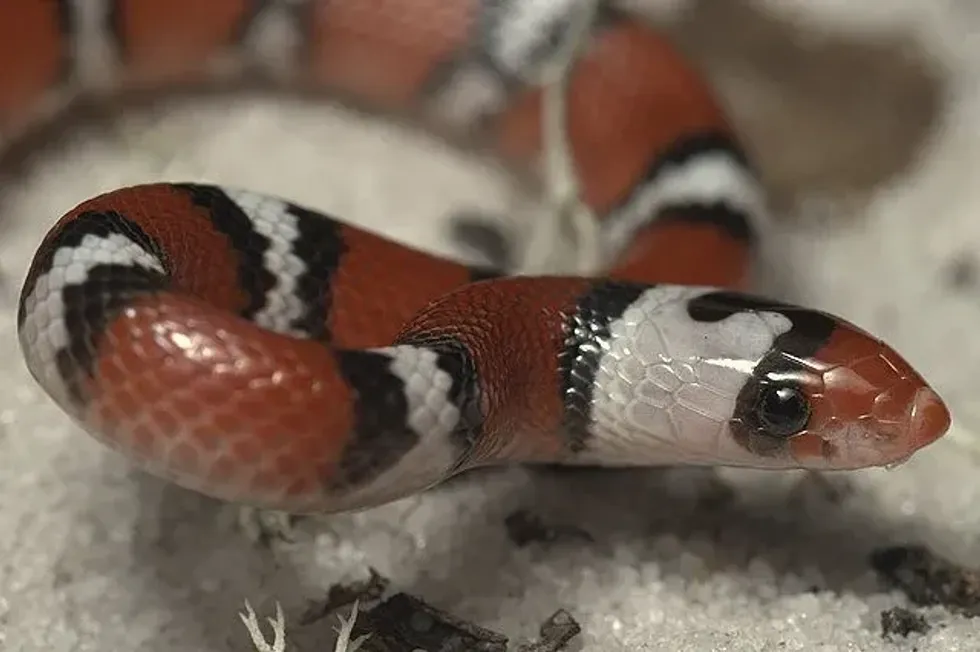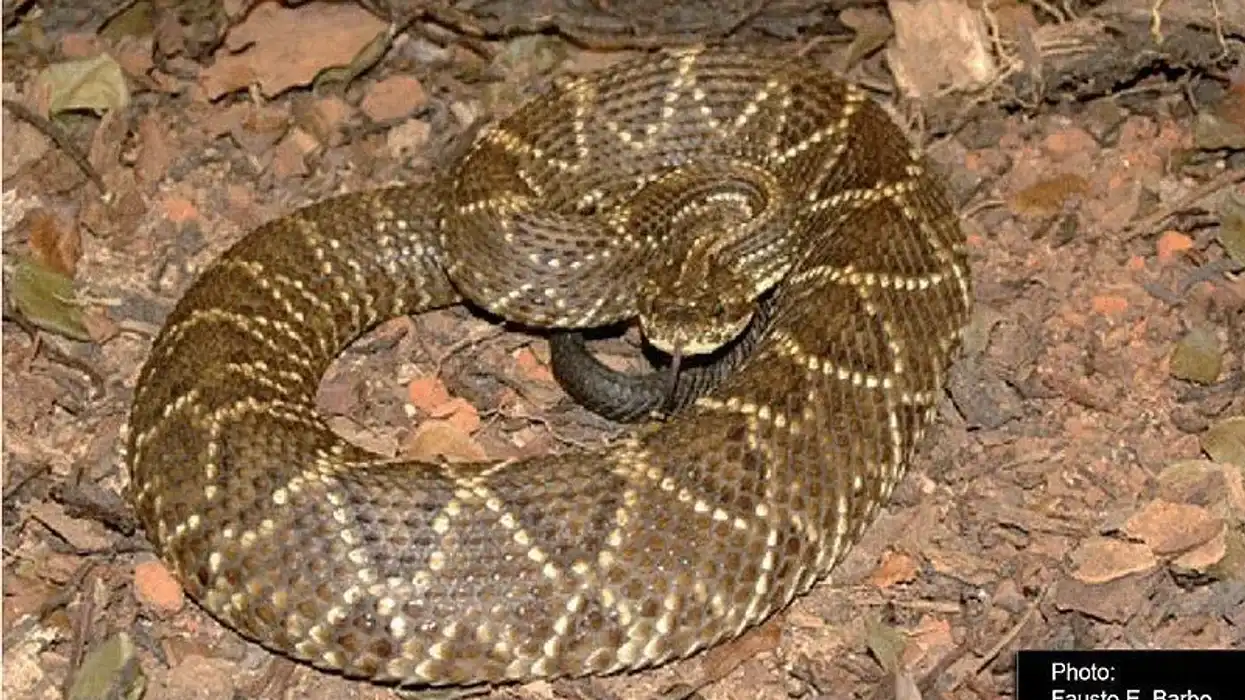The scarlet snake (Cemophora coccinea) is an endemic United States snake with a bright color mix of yellow, black, white, and red bands all over its body. Their red, white, black, and yellow coloration makes them quite handsome.
This non-venomous snake can be mistaken for venomous coral snakes. However, the venomous coral snakes are much larger than the scarlet snake. This species is quite small, with red, black, white, and yellow bands on its body.
Like most other snakes, the scarlet snake (Cemophora coccinea) has a carnivorous diet. The species Cemophora coccinea can be divided into subspecies Florida scarlet snake and Northern scarlet snake.
Both lay eggs and have bright colors all over them. Conservation activities have also been put forward for the preservation of this species.
While the species is in decline, the IUCN still puts the population of species under Least Concern. They prefer leaf litter areas and sandy soil adjacent to forest areas. Sandy soil helps them burrow better and stay underground.
The red color may help it stand out from other snakes and give it the 'scarlet' title. Read on to find out some more really interesting info about the scarlet snake.
If you like this article, you may also like to read up on black rat snake and cobra.
Scarlet Snake Interesting Facts
What type of animal is a scarlet snake?
A scarlet snake is a kind of snake.
What class of animal does a scarlet snake belong to?
A scarlet snake belongs to the class Reptilia.
How many scarlet snakes are there in the world?
Scarlet snakes are under Least Concern status as per the IUCN. The population is deemed to be stable. However, there are no specific numbers as to how many are present in the world as of now.
Where does a scarlet snake live?
The scarlet snake generally prefers grasslands. They are native to the United States. They can be found in Maryland, Kentucky, Missouri, south of Illinois and Indiana, southern Florida, and in the Gulf Coast region.
What is a scarlet snake's habitat?
The primary habitat of the scarlet snake is forests and grasslands. They mostly live in pine and hardwood forests.
However, even when they are living in these forest areas, scarlet snakes prefer to find open areas of loamy or sandy soil near their forests. They are known to lay eggs under moist soil. Specific habitats may include swamp borders, sandhills, grass prairies, and abandoned fields.
Who do scarlet snakes live with?
Like most snakes, scarlet snakes are mostly solitary in nature.
How long does a scarlet snake live?
It has been reported that the average lifespan of a scarlet snake is around ten years.
How do they reproduce?
Not much is known about the scarlet snake reproduction status. Like other snakes, they are oviparous. They are known to breed during springtime. The female snake can lay around 12-13 eggs. Females are known to lay more than one clutch per year. The secretive snake species generally lay eggs under rocks or underground burrows.
What is their conservation status?
As per the IUCN, the scarlet snake falls under the Least Concern status. Since they are distributed widely across the United States and as per tracking devices, their population seems quite stable.
Back in 2016, the New Jersey Endangered and Nongame Advisory Committee proposed that the scarlet snake should be considered under the 'Threatened' status. This was because habitat loss and illegal pet trade were causing a decline in the population of this reptile. Habitat alterations also affect the scarlet snake population.
Scarlet Snake Fun Facts
What do scarlet snakes look like?

Scarlet snakes are small and have black, red, and yellow bands. This makes them seem like false coral snakes. The belly has a whitish-grey tone. They have shiny scales. Their pointed head extends from their indistinguishable neck, and they have a colored band behind their round eyes.
How cute are they?
Scarlet snakes are brightly colored, especially with the red-yellow combination, and hence, they can seem quite cute. Plus, they are mostly docile and quite small.
How do they communicate?
In general, snakes use pheromones to attract the female. They can hiss or growl to try and scare off predators. When they are grabbed, they tend to coil up and then keep their head under the coil. They shake their tail after that in an attempt to distract predators from attacking their heads.
How big is a scarlet snake?
Scarlet snakes are around 14-20 in long. In comparison, the coral snake is slightly larger and stands at 18-20 in length.
How fast can a scarlet snake move?
Scarlet snakes are quite fast, but the speed of these snakes has not been recorded. Generally, the top speed of a snake has been recorded at around eight mph, but few reach that speed.
How much does a scarlet snake weigh?
Since the scarlet snake is not very well-studied, there is no clear data on the scarlet snake weight.
What are their male and female names of the species?
There are no male and female names for snakes.
What would you call a baby scarlet snake?
A newborn snake is called a hatchling, while a baby snake is called a snakelet.
What do they eat?
The primary diet of scarlet snakes is reptile eggs. However, the scarlet snake also feeds on salamanders, snakes, frogs, small mammals, and other invertebrates. Either they will swallow prey whole or squeeze the prey to death (also known as constriction).
Are they poisonous?
Scarlet snakes are not poisonous, and they do not bite that easily.
Would they make a good pet?
Scarlet snakes look great, and if you like reptiles, then they might seem like a good pet. However, scarlet snakes are considered Threatened by the New Jersey Endangered and Nongame Advisory Committee.
Hence, there could be states like Georgia where capturing or keeping scarlet snakes as a pet can be illegal. They are also not kept well in captivity, so, as a pet, they may not survive.
Did you know...
Scarlet snakes do not always bite in defense. At times, they often give out a foul smell to ward off predators.
How do scarlet snakes move?
During the day, scarlet snakes do not hunt and stay hidden. However, they become active at night. During the night, they can move above the ground. During the day, they tend to move in burrows.
Comparisons with other snakes
While scarlet snakes are non-venomous, other similar snakes can be poisonous. Hence, it is important to tell the differences between them.
Scarlet snakes can look similar to the scarlet kingsnake, but the scarlet kingsnake bands encircle their entire body. The scarlet snake bands do not completely encircle the body since they have a different-colored underbelly.
The Eastern coral snake is venomous and has a black snout with red and yellow bands. In contrast, the scarlet snake has a red snout, and the red bands are wider than the other bands.
Here at Kidadl, we have carefully created lots of interesting family-friendly animal facts for everyone to discover! Learn more about some other reptiles including coral snake, or kingsnake.
You can even occupy yourself at home by drawing one on our scarlet snake coloring pages.










